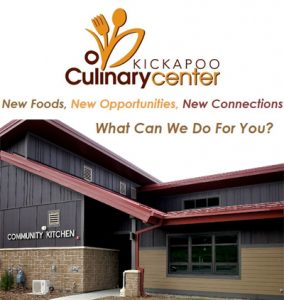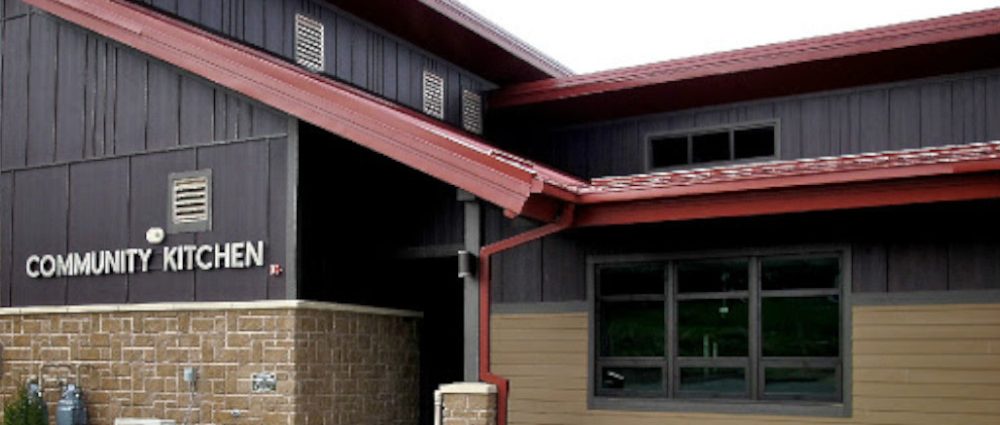 By: Julia Henley –
By: Julia Henley –
EXPANDING A MARKET
It is important to reflect on what can happen, just with the efforts of one person. For instance, without the Kickapoo Culinary Center, the American Hazelnut Company just might not exist, and new products for hazelnuts (flour, oil, seasoned nuts as snacks) might not be the latest up and coming product. Without Brad Niemcek, I doubt the Kickapoo Culinary Center would exist. Without Brad’s wife and partner Sharon Murphy, I also doubt there would be an emerging trail system in Gays Mills. I know Brad and Sharon have also contributed to a few more bees in the world, a number of community minded initiatives including farmers markets, and disaster support coming from that very kitchen to prepare and distribute meals throughout the valley, when, as predicted, the next big flood hit last year, almost stubbornly on schedule, 10 years after the big one of 2008. Niemcek never expected to be involved in the food industries. With a pretty impressive background, he enlisted as an airman out of high school. In the Air Force, he was tasked to learn Bulgarian. He both raced and marketed for the Formula 1 racing circuit in the 60s and 70s, then on to Washington DC and New York, not just marketing, but also participated in the creation of the emerging satellite cable industries covering sports. Brad has been in intense and competitive industries his entire life. Fascinated as I am with Brad’s work history, he really did know how to drive a tractor long ago before the fast lanes in life enticed him, which is more handy now than speaking Bulgarian I would think. Is that the litmus test to living in rural America, particularly in the Driftless Region? Brad’s response, “Not really, but a willingness to adjust, to alter, to embrace and create new things, is.”
Niemcek never expected to be involved in the food industries. With a pretty impressive background, he enlisted as an airman out of high school. In the Air Force, he was tasked to learn Bulgarian. He both raced and marketed for the Formula 1 racing circuit in the 60s and 70s, then on to Washington DC and New York, not just marketing, but also participated in the creation of the emerging satellite cable industries covering sports. Brad has been in intense and competitive industries his entire life. Fascinated as I am with Brad’s work history, he really did know how to drive a tractor long ago before the fast lanes in life enticed him, which is more handy now than speaking Bulgarian I would think. Is that the litmus test to living in rural America, particularly in the Driftless Region? Brad’s response, “Not really, but a willingness to adjust, to alter, to embrace and create new things, is.”
So why not a slower paced life in a small town trying to help make things happen?
Transition to Gays Mills. Not long ago, contemplating the reality of a retiring lifestyle, and of the potential of aging bodies (neither act their age, I can attest), the couple considered perhaps a condo in the burbs, or closer to larger cities. They soon realized what they had already is what they wanted. They are staying put, and with the help of an occasional handyman, it works. Lifestyle a slower pace, but clearly a very productive one, and the reasonable cost of living make it work.
Adapt. Be Resilient. Participate in something bigger than yourself.
Perhaps change itself is the ultimate force upon us all. Change is also facing incubators like the Kickapoo Culinary Kitchen. Niemcek worried initially he didn’t have experience in culinary arts—but he quickly found out that people that came into the kitchen, knew what they wanted to make, but they didn’t necessarily know how to make a sustainable business. That is his niche.
There is a challenge in incubators. In a recent national study of shared use incubators, there are obstacles. Consider the product of a shared use incubator kitchen: First to grow it –and the question is, can you consistently grow something? Then a new or better product, can you scale it up and process it? Then, you must hit the sweet spot of designing –or approving– compelling packaging and a brand message that has potential to sell. Then you sell it. And you ship it, in large and small quantities, to large and small entities. That alone is easily 4 or 5 full time jobs there. The undertaking is daunting for many. Co-packing is the emerging solution to all of this, allowing the entrepreneur to perhaps divide responsibilities, outsource, and then conquer. Still, the second most important thing, like a tech startup or shared use tech space, is a place to break out of production and actually talk with others also using the space. The first most important feature of a shared use kitchen is an experienced kitchen manager counselor. Enter Brad.
Brad is a wealth of information, and is willing to share, especially to all those that want to start something– Catering? Processing? Market your product? Plan your event? Start a restaurant, or an in-home food service? Process some nuts? Start a nationwide company that brings together producers and finds markets? It is a joy to do and see it succeed.
On the other hand, the research is showing that Co-packers are succeeding, where food incubators are not. Co-packing allows for pros to do parts of the business for you, and with enough cash to help get it started, grow faster, with less burnout for the business owner. Do what you do best, and make products a success. Given all the immigration discussion these days, interestingly, the most dynamic category of food start up entrepreneur, is the immigrant, perhaps due to the fact that they want to share what they used to love, with their new neighbors, and new neighbors, love new, delicious food. It’s not everyday cuisine. The bigger the market , the more ethnically diverse market, the better chance it has to thrive. What is the market here? “Local” is considered within 300 miles, which encompasses about 8 million people, but you wouldn’t know it from the location.
After most recent floods, the KCC opened to the community, and served breakfast, lunch and dinner, along with packaged foods for 9 days straight, to 4-5 distribution centers for the region recovering from disaster. A kitchen such as the KCC can be an important part of a disaster resilience formula for a rural community, and its impact reaches far beyond the immediate village limits. Regional cooperation and resources must be thought of in the face of erratic climate and this works. In 2013/14/15, Wisconsin had more food business incubators than any other state—compared to California, which only had 30, and a lot more people.
The Kickapoo Culinary Center (KCC) is doing fine, thanks to an adjacent space for events, and it’s largest client, the American Hazelnut Company, but as much as there are concerns, there are also ongoing opportunities for the entrepreneurial minded.
Oregon has the largest production of hazelnuts in the US market—over 90%. Hazelnuts are delicious, but not as perhaps popularly known as perhaps cashews or peanuts. Think that chocolatey concoction that is Nutella. That’s hazelnut territory. Back in the Midwest, where hazelnuts have grown for hundreds of years in the wild, a new market is growing, thanks to the American Hazelnut Company. For example, Oregon is an “8” (milder) growing zone, the Midwest, a 4.5. The variety of plants that produce so much in Oregon won’t produce the same, or survive, here. The wild nuts indigenous to Wisconsin are not easily harvested, and are smaller. Going forward from the wild Midwest hazelnut, to the larger, more abundant variety that can handle this weather, comes from a bit of agricultural cross hybridization. From there, plants need to be planted and nurtured and harvested. With enough plants in the ground, there is then enough raw material for product.
American Hazelnut Company organized in November of 2014. It originally had 10 grower investors, now have 26 (in the upper Midwest) Iowa/Wisconsin, Minnesota—as well as New York to Oklahoma. Product is being distributed and developed. More plants are growing, more outlets are selling.
Entirely too many people here that don’t know what is possible, and have lost the confidence they can make things happen
I asked Brad what motivates him. His response, “It is the fun of building something, seeing it work, have people say, ‘Oh, that’s cool!’” The biggest reason he points to all this effort is “a classic case of arrested social development”. He is still a kid at heart in many aspects.
Kickapoo Culinary Center
16381 Hwy 131
Gays Mills, 54631
(608) 485-3413![]()
Nutella is a registered trademark of Ferrero USA
2021-03-19

